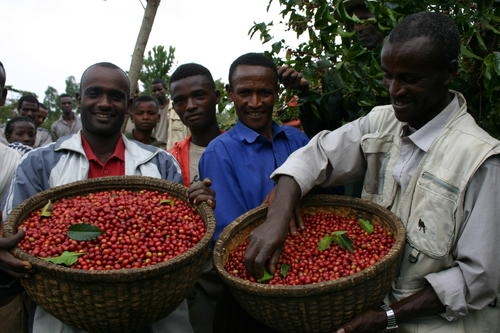Characteristics of Lion King Sun-flavored Coffee beans treated by Sebastian Dharma
The coffee flavor of Sidamo is very diverse, and the different soil types, microclimate and countless native coffee species make the coffee produced in each town have obvious differences and characteristics. In 2010-12, it won three consecutive high marks from coffee review 92 to 94, which shows the extraordinary value of raw beans in this area! The territory is covered by towering mountains, highlands, plateaus, valleys and plains with a variety of topography. The geology of the area belongs to the fertile and well-drained volcanic soil, which is nearly two meters deep and the surface soil is dark brown or brown. The biggest advantage of this place is that the soil fertility is maintained through the circulation of natural organic matter, with the withered leaves or litter of the surrounding trees and the residual roots of plants as natural fertilizer. This batch is produced by Sirsa Shilcho Cooperative near Dilla Town. The cooperative was founded in 1976 and is currently a member of the Sidamo Farmers' Cooperative Union SCFCU (Sidamo Coffee Farmer Cooperative Union). We have screened the coffee again and again and selected this batch for excellent flavor.

Ethiopia is the country where coffee was first discovered. Today, there is still a lot of wild coffee for farmers to harvest in the primeval forest. Ethiopia is a country with poverty, drought and civil war, but it is still the most important coffee producer in terms of coffee quality and output, and it is also the best and top coffee producer in the past year or two.
Ethiopian coffee can be divided into two treatments. Washing treatment method II. Natural sun treatment. Nowadays, every cooperative or even a small coffee farm in Ethiopia produces coffee beans of the above two treatments at the same time, whether it is the well-known Yegashev producing area in Taiwan or the Sidamo producing area. Not only that, in Ethiopia, which is currently the country with the fastest development of coffee, it not only makes coffee different in treatment, but also makes aroma and taste different due to the adjustment of different techniques and processes. Yegashev sun beans are different from Sidamo sun beans in aroma, which often gives people an illusion. The aroma is mild, low-sinking, citric acid is soft and low-key, the consistency of flavor is high, and the taste of Isopia coffee beans is won by taste, while the strong aroma of Esopia coffee beans shows strong aroma, the weak flavor of citric acid is not obvious, and the complex flavor is characterized by flower or fruit fragrance.

In recent years, many emerging small producing areas or cooperatives in the Sidamo and Yekashev producing areas will be sold in the international market under the name of their own cooperatives or farms, which shows confidence in their own coffee. Hope to establish brand and loyalty in the international coffee market, coffee farmers insist on picking mature coffee beans and strictly handle every process, whether it is natural washing or natural sun drying. Unexpected aroma and excellent taste, which I think is the reason why Ethiopian coffee is expected by coffee fans every year. For example, the Dutch government-assisted Red Cherry Project (Operation Cherry Red) impressed the world with the magnificent aroma of strawberry cookies in 2008 and Cambedo Manor in 2009, which has been reinforced by the sun beans produced in Ethiopia in recent years.
Local farmers in West Dharma manually select moderately mature coffee cherries for sun treatment, turning the coffee cherries on the scaffolding every two hours during the sun for about 15 to 17 days. to ensure that the coffee cherries are evenly and completely dry, followed by shelling and packaging.

Important Notice :
前街咖啡 FrontStreet Coffee has moved to new addredd:
FrontStreet Coffee Address: 315,Donghua East Road,GuangZhou
Tel:020 38364473
- Prev

Boutique coffee Guatemala coffee beans introduction to Guatemala coffee beans
Coffee production in Guatemala has declined relatively, at 700kg per hectare, while that in El Salvador is 900kg per hectare and that in Costa Rica is even more astonishing, at 1700 kg per hectare. The export of dangerous Dimara coffee is controlled by private companies, but the National Coffee Council (Asociacion Nacional de Cafe) controls the coffee industry.
- Next

Coffee beans treated with Red Honey in Fire Phoenix Manor in the Valley of Central Costa Rica
Located in the fertile hills of the Poas volcano in the central valley of Costa Rica, Fenghuang Manor is the first producer in Central and South America to produce honey-treated and sun-cured coffee. It is a completely 100% organically grown coffee manor. The owner believes that organic farming is a better choice for environmental maintenance and family health, even in the face of many technical and organizational
Related
- Does Rose Summer choose Blue, Green or Red? Detailed explanation of Rose Summer Coffee plots and Classification in Panamanian Jade Manor
- What is the difference between the origin, producing area, processing plant, cooperative and manor of coffee beans?
- How fine does the espresso powder fit? how to grind the espresso?
- Sca coffee roasting degree color card coffee roasting degree 8 roasting color values what do you mean?
- The practice of lattes: how to make lattes at home
- Introduction to Indonesian Fine Coffee beans-- Java Coffee producing area of Indonesian Arabica Coffee
- How much will the flavor of light and medium roasted rose summer be expressed? What baking level is rose summer suitable for?
- Introduction to the characteristics of washing, sun-drying or wet-planing coffee commonly used in Mantenin, Indonesia
- Price characteristics of Arabica Coffee Bean Starbucks introduction to Manning Coffee Bean Taste producing area Variety Manor
- What is the authentic Yega flavor? What are the flavor characteristics of the really excellent Yejasuffi coffee beans?

